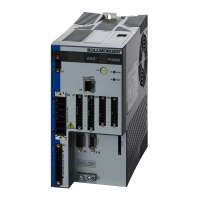DIN3.MODE =3
The state of input 1 and 3 is 1.
The state of input 2 is 0.
Motion task 5 (2
0
+2
2
) will be executed.
Mode 4: Motion Task Start Selected
This mode is used to start the motion task that is stored in the servo amplifier, by giving the motion task number.
This input utilizes a secondary variable for the motion task number to be started with the Input trigger. The sec-
ondary variable is set by mode 3 (Motion task select bit).
Motion task number “0” initiates homing/reference traverse. A rising edge starts the motion task and a falling
edge cancels the motion task.
Mode 5: Start Home
This mode is used to start the homing motion task on the rising edge. The falling edge has no effect on this input
mode of operation.
Mode 6: Start Jog
This mode is used to start a jog move. This input mode utilizes a secondary variable for the jog’s velocity. The
jog will start upon a rising edge. A falling edge stops the jog.
Mode 7: Reserved
Mode 8: Zero Latch
This mode is used to define the current drive position as the zero pulse for the drive EEO and sets the incre-
mental encoder zero pulse offset. The current position, depending on the incremental encoder resolution that is
set, is calculated at the rising edge and stored as an offset. An automatic save is then generated. This function is
used to perform an automatic setting of the zero pulse in one turn of the motor.
Mode 9: Command Buffer
This mode is used toexecute four different sets of commandbuffers. Eachset contains two buffers: low andhigh,
fora total of eight buffers. DINx.PARAM for this mode canbe 1to 4, and determines which set of buffers to use.
Toset thehigh andlow values of theeight buffers from theterminal screen, use the commands DIN.HCMDx and
DIN.LCMDx (1<=x<=4). Use";" toseparate thetwo buffercommands. Eachbuffer contains up to128 characters.
Example:
-->DIN1.MODE 9 (sets command buffer mode to digital input 1)
-->DIN1.PARAM 1 (sets the first set of buffers to digital input 1)
-->DIN.HCMD1 DRV.OPMOE 1; (sets high command buffer)
-->DIN.LCMD1 DRV.OPMOE 0; (sets low command buffer)
Under this configuration, a rising edge in digital input 1 will set DRV.OPMODE to 1 and a falling
edge will set DRV.OPMODE to 0.
You can also set the command buffers from the Digital I/O view in WorkBench; see 10.2 Command Buffer
Mode 10: Control Fault Relay
This mode is used to create an external fault.
Input state is 0 – drive regular behavior
Input state is 1 – “Fault 245 – external fault” is issued.
Mode 11: Home reference
This mode is used to receive a physical home reference switch located on the machine to use for the different
Home Types.
Mode 12: Reserved
AKD User Guide | 10 Configuring General Drive Settings
Kollmorgen | December 2010 85

